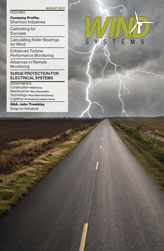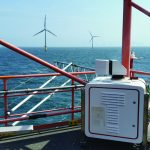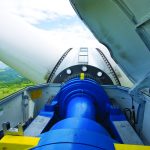In the world of maintenance there is generally an accepted rule in system troubleshooting that states the best methodology should attempt to eliminate at least half of the probable causes of component failure at each step of the process. This technique is termed “half-splitting,” whereby instead of sequentially testing each and every component of a malfunctioning loop from beginning to end, you begin with the middle component. With each verification step, the technician should be able to isolate half the circuit as the cause of the problem. While the time saved by using this method will depend on the length of the faulty path and the location of the fault, on average half-splitting is almost twice as fast as the sequential method of tracing a signal from point A to point B. Using a wind turbine as an example, when technicians arrive at a faulted unit they ask themselves if the problem is mechanical or electrical, thus narrowing down half of probable causes immediately.
Getting to the heart of the problem quickly is important when addressing turbine faults and eliminating those that occur frequently or cause high amounts of downtime. A monthly fault listing should reveal one thing to the project team: dollars lost. Using one of the seven tools of quality control, the Pareto chart is a bar graph that can display variances, or turbine faults, by the number of their occurrences or MWs lost. Faults are shown in their descending order to identify the largest opportunities for improvement, and to separate “critical few” from the “trivial many.” Aside from the familiar station outage or scheduled maintenance downtime, the Pareto chart identifies faults that contribute the most to production loss. A project operator will find that these typically fall into two broad categories: those that recur frequently for short periods of time due to a systemic issue, and those that are infrequent but require a turbine climb for investigation and resolution.
Frequency of a fault, while it may be resettable by remote operation, can be just as impactful to the bottom line as a fault that occurs only once but must be tended to by a technician. A valuable exercise in understanding this concept is to look back a year and review the annual event rate for each of your high-visibility faults, determine the average downtime incurred, cost per event, and downtime cost per hour. Essentially, these are your unavailability performance drivers, and are the ones that contribute the most negative impact to your reliability metrics and bottom line.
In wind maintenance, it’s helpful to know that solutions to many issues, including turbine faults, are repeatable. A yaw brake pressure fault that occurs nine times on nine separate turbines in the same month should only need to be resolved on the first turbine and then repeated and verified on each of the others. If the fault has been correctly diagnosed and resolved, it would be the basis of training the team on where to look first in correcting any of these future faults. Getting to that level of process knowledge that boosts effective root cause analysis is necessary to remove faults from your monthly Pareto. A technician armed with experience and a maintenance manual will generally look for solutions with the highest probability of fixing the underlying problem, and he or she would employ half-splitting techniques to get there. Not everyone works this way, though, and it can be proven with a productivity cutting, human nature-type test with a coworker. Simply unplug their computer monitor cord and watch what steps are taken to find root cause when they return to their desk. In reading this we would expect the most efficient path is to first check the obvious and easiest reasons why the monitor stopped working. Instead, you will likely witness everything short of a call to the Geek Squad before your coworker realizes the cord has been pulled. We would all find the cord eventually, but at the beginning of this troubleshooting exercise we are missing one of the essential knowledge components necessary to troubleshoot it: understanding the process of how the monitor receives its signal. Similarly, in a wind turbine with a frequent safety line or comm fault, it is DC voltage issues that can elude many good technicians.
Reducing the frequency and number of faults that drive unavailability should be a common goal of the project team. Distracted with scheduled maintenance and major repairs, an annual analysis of frequent turbine faults that cause downtime can shed light on what seemingly nuisance-type issues are really eating your lunch. Starting with an evaluation of the annual dollar impact, the effort in reducing these faults can best be addressed through smart troubleshooting practices and a thorough understanding of the turbine control process. Significant gains in eliminating turbine faults can be made by simply recognizing the differences between sequential and half-splitting techniques, and by distinguishing between possible and probable causes.



































